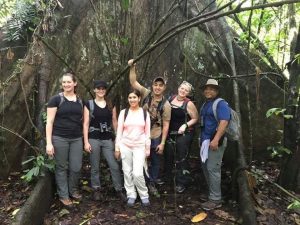The Kapok tree (Ceiba pentandra), often referred to ceiba or silk cotton tree, is native to the Neotropics. Kapoks are easy to spot because of their size and giant limbs (buttresses). They can be up to 200 ft. tall and have a diameter of up to 10 ft. It is easy to assume that these tall trees are of ancient age when we encounter them, but they are often much younger than what we think as they can grow up 13 ft in height per year. These tropical deciduous trees have white and pink flowers that produce a particular smell that attracts bats for pollination. The kapok tree also produces a unique brown pod-like fruit that is convenient for its reproduction. The pods are filled with a cotton-like fiber that contains the seeds; these pods can float in water and release the seeds in a far away area from the parent tree. When the pods open, the fiber is light enough to float through the air and spread the seeds far.
Besides having an attractive appearance, the Kapok tree provides shelter for many species in its canopy, bark, and giant limbs. Humans have also benefited from these trees for centuries, and it is believed to have been sacred for the Mayas! Its long and smooth trunk is used to build canoes and coffins. The fiber inside the pods has many uses including padding for floating garments, pillows, and insulation. Properties found in the leaves and deeper in the trunk have also been used for medical treatments including asthma and kidney problems. A study in 2006 (Rao et al.) found that activated carbon derived from the Kapok can absorb cadmium and copper from aqueous solutions.
The Kapok provides so much for our society that it would be logical to conclude that its abundance might be decreasing due to increasing demand. But this is not the case. The tree is not even listed by the IUCN or other conservation organizations. Next time you are in a tropical area keep your eye out for these majestic trees!
References:
Blue planet biome organization. http://www.blueplanetbiomes.org/kapok.htm
Rainforest alliance. Species profile, http://www.rainforest-alliance.org/species/kapok-tree
Rao, M. M., Ramesh, A., Rao, G. P. C., & Seshaiah, K. (2006). Removal of copper and cadmium from the aqueous solutions by activated carbon derived from Ceiba pentandra hulls. Journal of Hazardous Materials, 129(1), 123-129.

